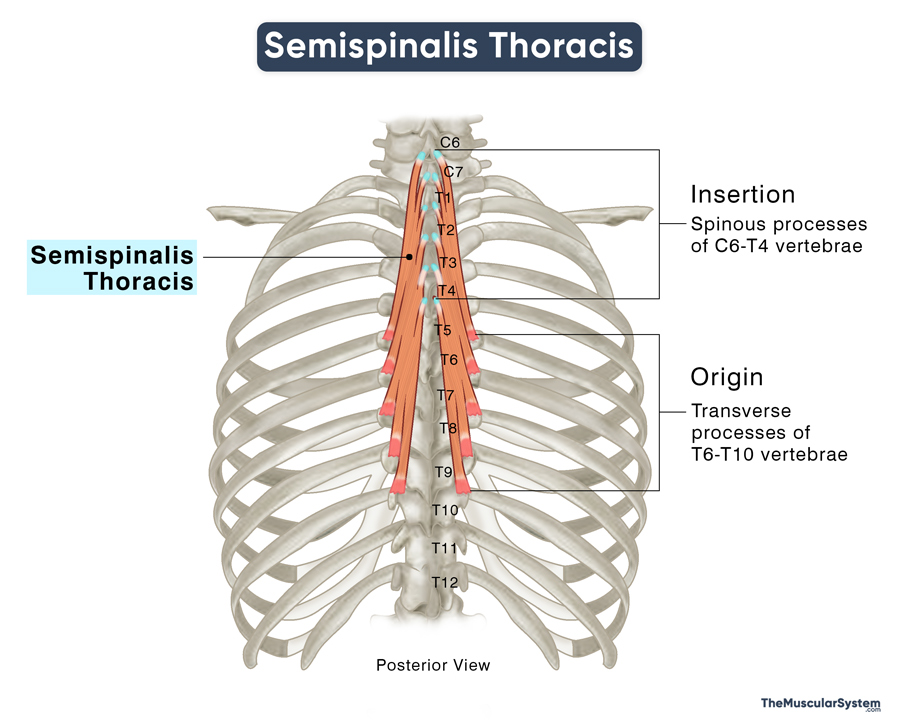Semispinalis Thoracis
Last updated:
10/05/2025Della Barnes, an MS Anatomy graduate, blends medical research with accessible writing, simplifying complex anatomy for a better understanding and appreciation of human anatomy.
What is the Semispinalis Thoracis
The semispinalis thoracis is a narrow muscle located in the upper to mid-back region. It is the lowest of the three semispinalis muscles, belonging to the transversospinalis or deep intrinsic back muscle group. Along with the other semispinalis muscles, it helps with the extension and rotation of the head and neck.
Anatomy
Location and Attachments
| Origin | Transverse processes of the T6 to T10 vertebrae |
| Insertion | Spinous processes of the C6 to T4 vertebrae |
Origin
Like other muscles attached to the vertebrae, the semispinalis thoracis begins as several thin fascicles, each originating from the transverse processes of the 6th to 10th thoracic vertebrae. In some cases, this origin may extend to the 11th and 12th thoracic vertebrae. These tendons then merge as they move upward, forming a single muscle belly that continues toward the cervical spine.
Insertion
As the muscle reaches the upper thoracic region, it splits into smaller sections that attach to the spinous processes of the 6th to 7th cervical vertebra, down to the 1st to 4th thoracic vertebra. The muscle fibers follow a laminated arrangement, meaning those originating from the lower vertebrae, like T10, are inserted lower at T4, while fibers from higher points, such as T6, are inserted higher at C6.
Relations With Surrounding Muscles and Structures
The erector spinae muscles lie lateral to the semispinalis thoracis, while it has the spinous processes of the thoracic and cervical vertebrae lying medially. The spinalis thoracis covers the muscle superficially. On the deep side, it has the other transversospinalis muscles, rotatores, and multifidus, as well as the levatores costarum.
Function
| Action | Extending, laterally flexing, and rotating the head and body trunk |
The semispinalis muscle works in synergy with other muscles in its group. When it contracts bilaterally (on both sides), it extends both the cervical and thoracic spine, allowing you to tilt your head backward to look overhead and to arch your back, bending the entire trunk backward. Notably, the semispinalis thoracis is the only muscle in this group that significantly contributes to thoracic spine movement and, consequently, the movement of the body trunk. This is due to its greater attachment to the thoracic vertebrae, extending down to T10.
When the semispinalis muscle contracts unilaterally (on one side), it aids in the ipsilateral lateral flexion of the head and trunk, allowing you to tilt your head and upper body toward the same side as the contracting muscle. Additionally, it plays a role in rotating the head and trunk toward the opposite side of the contracting muscle (contralateral rotation).
Innervation
| Nerve | Dorsal rami of cervical and thoracic nerves |
The medial branches of the posterior or dorsal rami of the adjacent thoracic and cervical spinal nerves innervate the muscle.
Blood Supply
| Artery | The dorsal rami of the posterior intercostal arteries |
The primary blood supply to the Semispinalis Thoracis muscle comes from the posterior intercostal arteries, which originate from the thoracic aorta.
References
- Semispinalis Thoracis Muscle: Elsevier.com
- Semispinalis Thoracis Muscle: GetBodySmart.com
- Semispinalis Thoracis Muscle: Kenhub.com
- Semispinalis thoracis muscle: IMAIOS.com
- Semispinalis: TeachMeAnatomy.info
Della Barnes, an MS Anatomy graduate, blends medical research with accessible writing, simplifying complex anatomy for a better understanding and appreciation of human anatomy.
- Latest Posts by Della Barnes, MS Anatomy
-
Hip Adductors
- -
Adductor Magnus
- -
Adductor Longus
- All Posts






